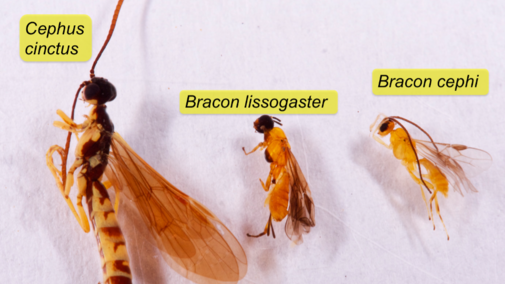The wheat stem sawfly (Figure 1) has emerged throughout the High Plains. Adult flights will likely peak this week based on the weekly monitoring at the High Plains Ag Lab (HPAL) near Sidney, Nebraska. It is projected to be a season with fairly high pressure but less than last year.
Additionally, as one walks wheat fallow fields, you can also find wheat stem sawflies flitting around the residue, regardless of what the annual crop might be. This is because the wheat stem sawfly survives from mid-July through May in the pupal stage within wheat residue left behind from the previous harvest.
Wheat stem sawfly surveys conducted from 2011-2017 indicated that the pest was staying within the Panhandle of Nebraska at that time, with southwestern counties such as Keith, Perkins, Chase, Dundy, Lincoln, etc. reporting zeroes. However, it is likely that the sawfly has been expanding its range since 2017, with confirmed presence of wheat stem sawfly in Perkins County at the Stumpf International Wheat Center by Nebraska Extension Educator Samantha Daniel on May 23, 2024. Presence of wheat stem sawfly in Keith County has also been reported, and it is possible that this insect has expanded to other parts of southwest and west-central Nebraska.

The current distribution range of wheat stem sawfly in Nebraska is shown in Figure 2. If you believe that wheat stem sawfly is present in your region and is not shown on the map below, please reach out to Pin-Chu Lai (308-632-1369). You can help us learn more about wheat stem sawfly infestation in our region by sharing your sawfly observations with us.
So, what can a wheat grower do now? If you believe that your infestation will result in losses close to or below your crop insurance guarantee, turn in a probable loss claim with your crop insurance agent now. However, from a production standpoint, there is not much you can do in this growing season. We recommend gathering information about which of your acres seem to have the highest sawfly infestations and be timely in harvesting heavily infested fields.
As your wheat fields begin to ripen, consider cutting some handfuls of wheat at a few locations across your wheat fields, split 25-50 handfuls of tillers and observe any tillers with frass or “sawdust” within the tillers. No other insect that infests wheat will leave behind frass within the tillers, which will otherwise be mostly hollow (unless you planted a solid-stem variety). Take notes on where and which fields you find sawfly infestation and this may provide insight for what you could do this coming fall or spring to manage your fallow for sawfly, or help you make decisions for variety selection or winter crop choice this for this fall.

